You may be used to imagining tortoises in varying sizes as they naturally grow larger as time goes by. These creatures are known to be popular pets for their gentleness though the size is important.
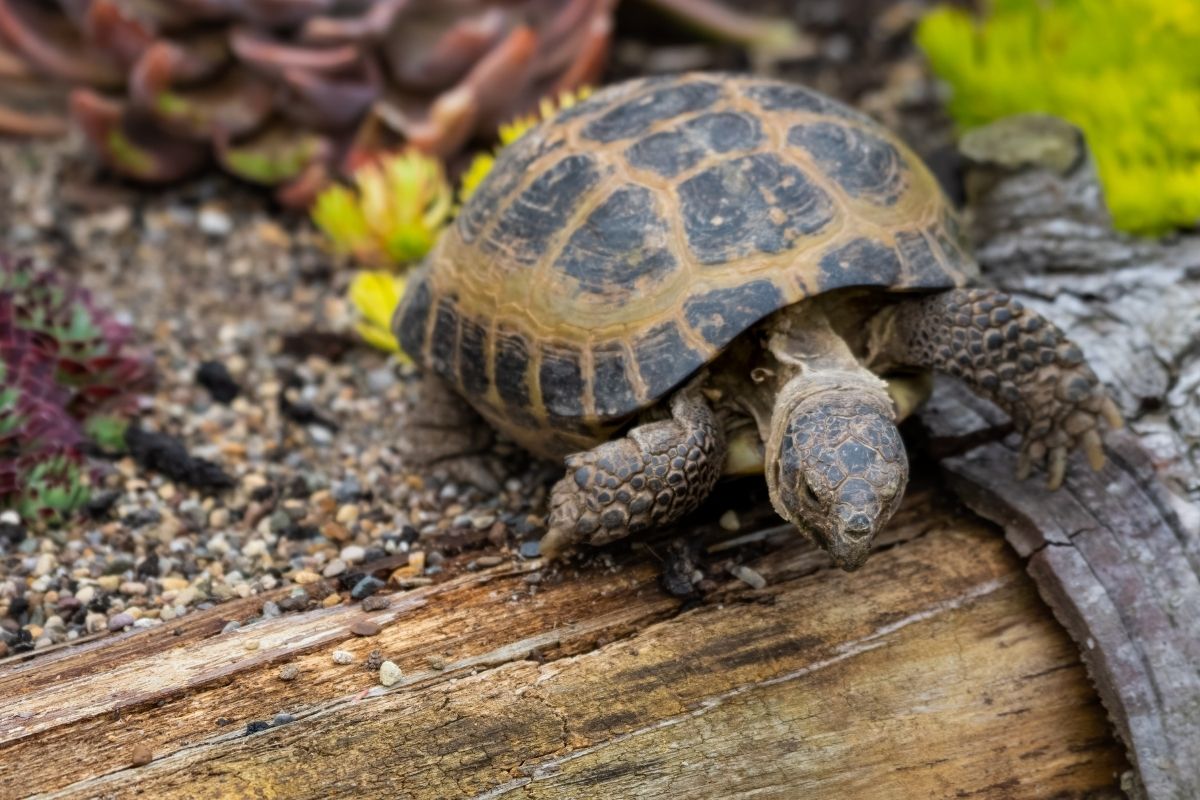
This could be from a tiny couple of inches in length to over six feet for a Galápagos giant tortoise.
However, there are certain tortoises that will remain small in size throughout their lifetime.
In this guide, we will look at six types of tortoises that stay small if you want a diminutive pet to look after that you know will not outgrow its surroundings.
These types of tortoise are Egyptian (Kleinmann’s) Tortoise, Greek (Spur-Thighed) Tortoise, Indian Star Tortoise, Hermann’s Tortoise, Russian (Horsefield) Tortoise, and Pancake Tortoise.
Why Small Tortoise Breeds Are Sought After
Looking after any pet can be challenging as they come with their requirements, yet with a smaller breed of tortoise, it can be made a bit easier.
They require less food and remain a diminutive size throughout their lifetime. Each breed has its characteristics, preferences, and temperament, which mean different levels of care.
However, the smaller breeds can come in at a higher price tag and legal documentation, which is worth considering.
With any pet, you should consider one that you can care for properly. For instance, if you have limited living space like an apartment, you may be better placed to look after a mini tortoise rather than a giant one.
Ensuring the right type of housing with the most ideal food is crucial for their comfort and also their survival and health.
Other considerations should be simply how cute and adorable they can be as well as how much food they require.
Small Tortoises
Now that we have covered why people want a small tortoise, let’s dive in and look at six tortoises that will stay small!
Egyptian (Kleinmann’s) Tortoise

The smallest of the mini tortoises that you can find is the Egyptian tortoise, which is also known as Kleinmann’s tortoise.
While the female Egyptian tortoise can grow up to five inches in length, a male Egyptian tortoise can only grow to be between three and four inches long.
This remains a particularly popular tortoise but one that is under threat as it is hard to find in the wild and is considered to be critically endangered.
As the Egyptian tortoise is so small, you only need an enclosure that measures around four cubic feet, making it ideal for those with a small living space.
However, they are particular about their heating, and it should be between 75 and 85°F constantly.
You may be surprised to learn that an Egyptian tortoise can do well when left indoors, even when the humidity is left artificially controlled though it should be between 20 and 30% in its enclosure.
Due to its endangered status, you may only find this type of tortoise at a recognized breeder or one that is specifically licensed.
There is a chance you can find one overseas in its native Egypt, Libya, and Israel, where it roams in rocky escarpments, sandy gravel plains, deserts, and semi-deserts, yet if you do, then getting it home can be difficult.
If you do choose to get an Egyptian tortoise across from a foreign country, then you have to take the time to check that the documentation is current and valid while the shipping records are all in order.
Failure to do so risks having the tortoise confiscated. You could even be sent to jail for wildlife trafficking.
The Egyptian tortoise can also be quite fussy about its surroundings, and you may have to work hard to keep it happy. If the environment is right, then you can be rewarded with a calm and peaceful tortoise.
They are known to come in at a high price as the breed is so hard to come by and is highly protected internationally.
Indian Star Tortoise

Another mini tortoise is the Indian Star tortoise which can be identified by the pattern of golden stars that decorate its shell.
Again, the females grow to be larger than the males at between seven and eight inches compared to just five and six for this diminutive variety.
Typically found in parts of Sri Lanka, another native habitat is India which means that this particular species thrives in a range of humidity levels as it is known to experience monsoons and then dry seasons.
The Indian Star tortoise is known for its gorgeous appearance with scutes of black or dark brown color.
There may also be yellow lines coming from the scute’s center.
As well as being beautiful, this tortoise is also calm and performs well with females by not harassing them to the extent of other varieties and can be very affectionate.
Another excellent plus point is that it should not try to escape as it fails to climb or burrow so the barrier can be kept short.
Back in India and Sri Lanka, this type of tortoise is widely traded, which is considered to be illegal for this critically endangered species.
Therefore, it is not possible to export an Indian Star tortoise, so you can only purchase one via a recognized breeder in your own country.
Once you get one, you would find that it does well in outdoor enclosures when the temperature is kept to between 80 and 90°F.
They can also be kept indoors, as long as the tank is over three square feet in size for a spacious environment and there is a bowl of water for them to soak in.
Hermann’s Tortoise
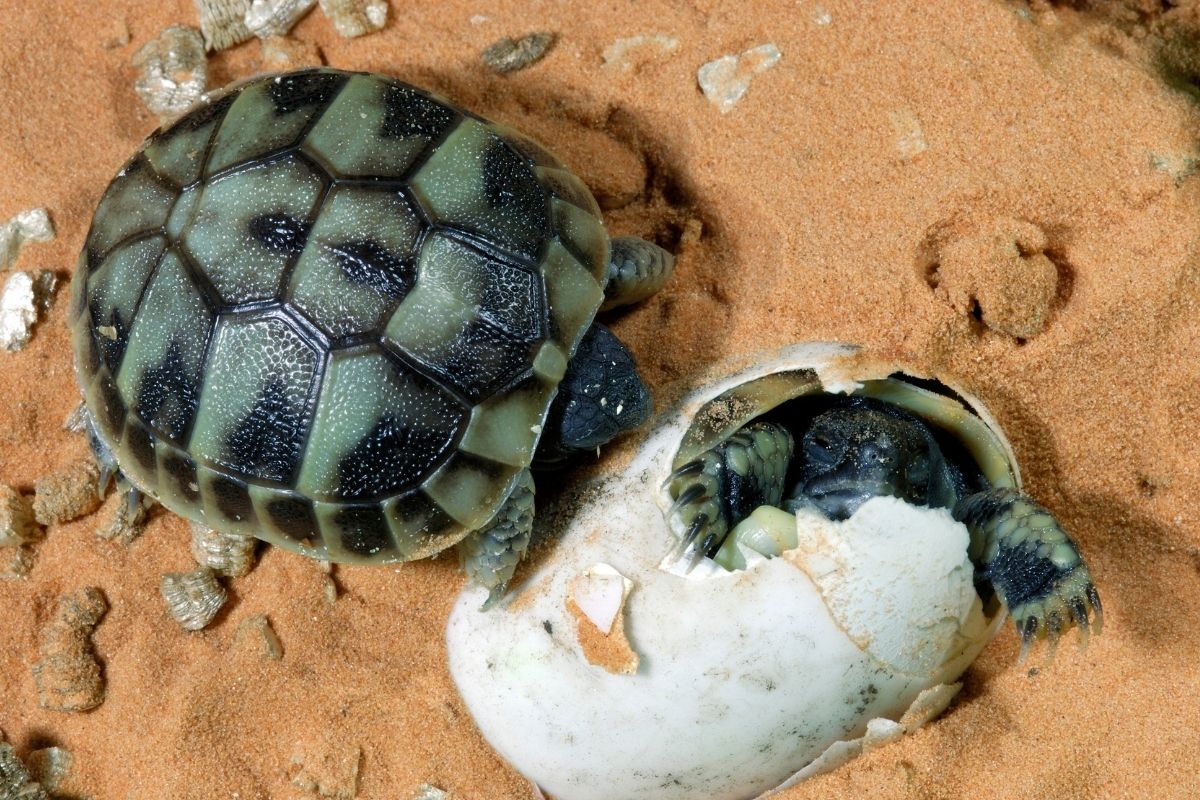
There are two different forms of the same tiny Mediterranean species. These include the Western Hermann’s, which originates from Italy, Corsica, and Spain.
The Eastern Hermanns would be found in Romania, Albania, Serbia, and Turkey.
There is also a difference in size as an Eastern Hermann’s will typically be a bit larger at up to seven inches for a male and then nine inches for females but Western Hermann’s should only get as long as five inches for males and six for females.
You could also spot the difference between a Western and Eastern Hermann’s as the latter are usually broader and flatter compared to a rounded Western Hermann’s.
The colors will also differ slightly as an Eastern Hermann can come in light tan, muddy brown, and yellow, whereas a Western Hermann’s will either be yellow, golden or orange.
Either type of Hermann tortoise should be playful yet docile while enjoying both indoors and outdoors with spacious surroundings that are well-secured.
This tortoise is not shy, and that space should be around 16 by 10 feet for particularly spacious roaming.
The environment is also important and should be as close to its natural Mediterranean habitat as possible with a maintained temperature between 70 and 80°F with a basking area and UV lights.
Finally, make it an enjoyable environment with large rocks and non-toxic plants, so the tortoise does not get bored easily and even consider leaving food around for it to find to remain active.
Greek (Spur-Thighed) Tortoise
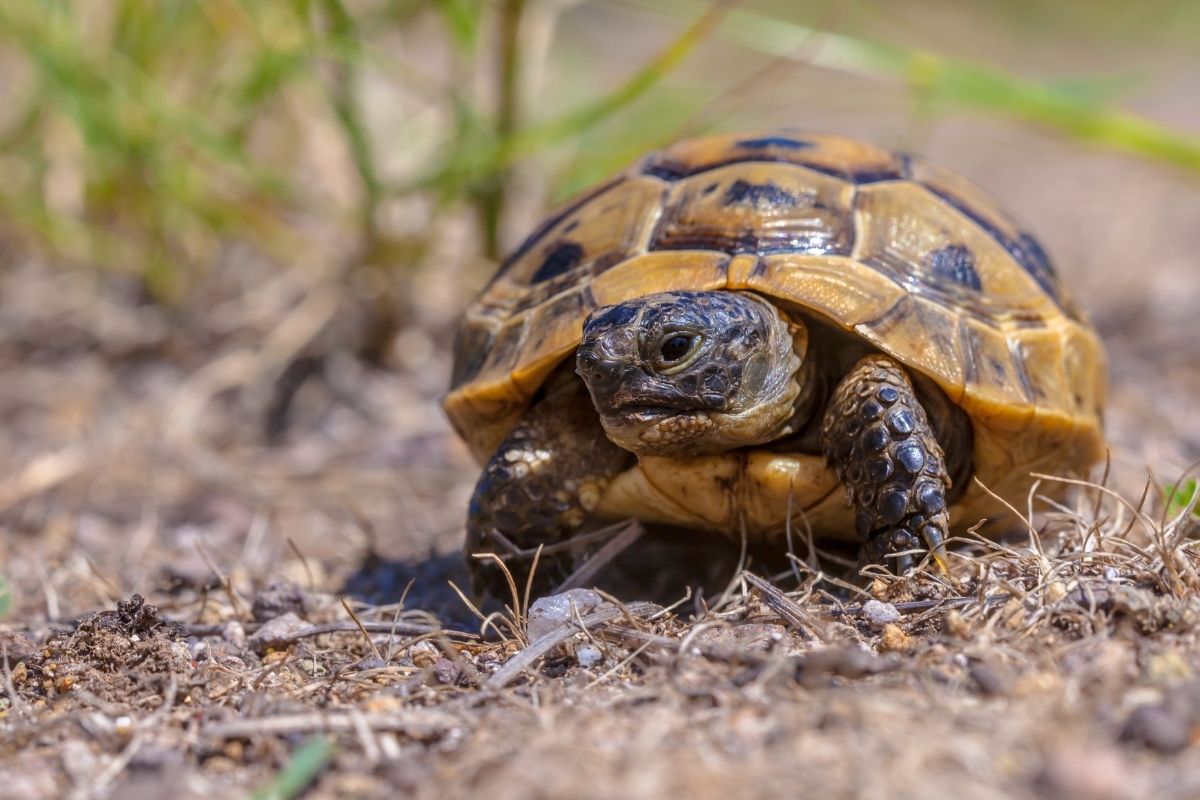
Another tortoise you would naturally find in the Mediterranean region is the Greek tortoise, also known as the Spur-Thighed tortoise.
The name comes from the spurs which appear on either side of its tail though other signs include its domed shell, which can be in black or gold.
Ensure there are plenty of leafy greens and vegetables, such as broccoli, as this is a herbivorous species that can live for up to 125 years, so needs some good food.
Its temperament is said to be mellow, which may go some way toward explaining how long it can live.
The Greek tortoise is peaceful and decides on love and not war, though can get peeved if the enclosure is deemed to be cramped.
Make sure there are a few hiding boxes, and the environment looks as natural as possible, and it should be fine.
Chances are you will need a large outdoor enclosure as this particular type of tortoise enjoys exploring, so let it roam in a spacious environment that measures around 18 square feet.
In its natural habitat, the Greek tortoise is known to be found in coastal dunes and thorny scrubs.
The temperature in the basking area is also crucial and should be kept at around 75 to 85°F.
Look after this tortoise if you get one, as not only can they live to a ripe old age, but their population is also declining.
Russian (Horsefield) Tortoise
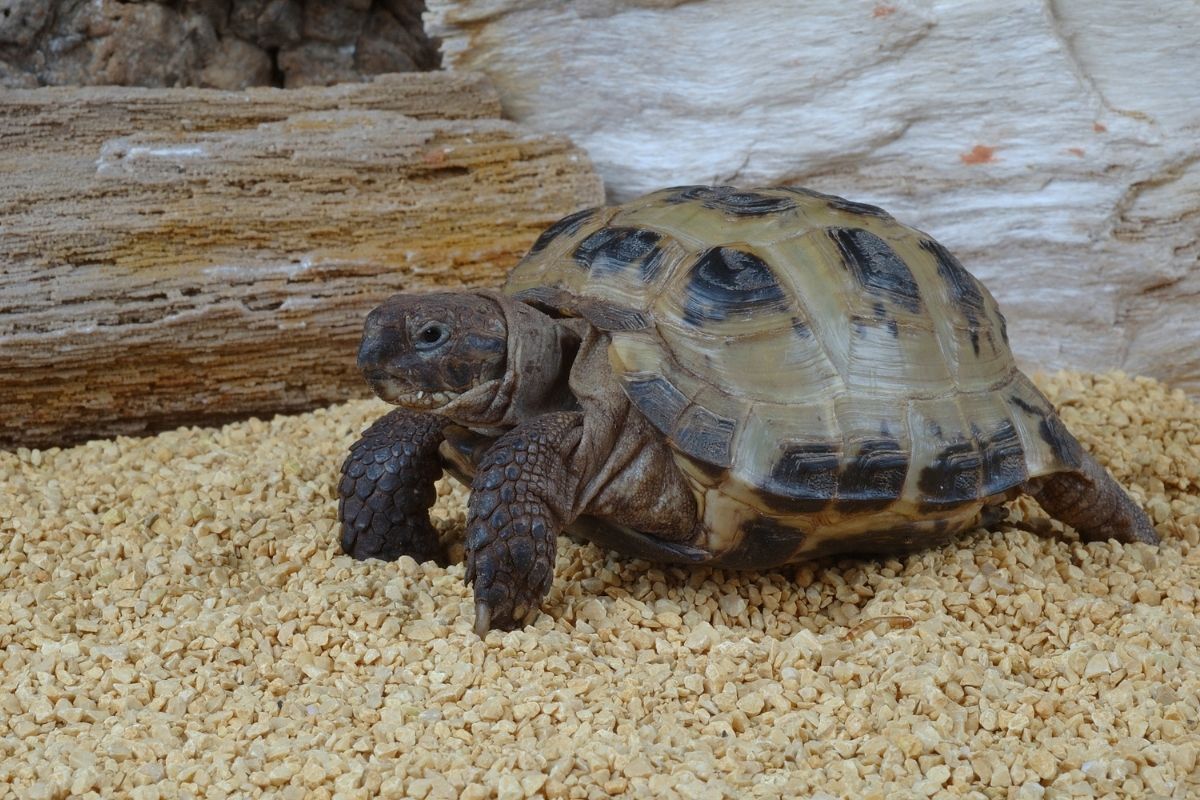
Also known as the Horsefield tortoise, a Russian tortoise makes a sound investment for anyone who has a tortoise as a pet for the first time.
They are typically fun to play around with and bond quickly with their owners.
There is also a difference between how long the different genders can grow, too as a male Russian tortoise may only measure between five and six inches long while a female can grow even longer at nine inches when fully grown.
It is a popular tortoise in the US and can be broadly found anywhere from the Middle East stretching to Southeastern Russia, which is quite a large area to cover.
As you may expect, this is a tough and resilient species that can do well in various conditions, so should be easy to look after.
You can expect a black, brown, tan, or olive green shell with four claws on each foot which are ideal for climbing or burrowing as it is particularly active.
With that limited size in mind, you may only need a medium-sized tortoise table that measures around four by two feet to house them.
The Russian tortoise also acclimatizes well and can be exceedingly tolerant at different temperatures.
You should still keep the humidity balanced, and this should be kept between 30 and 50%. Any more than that, and you risk shell rot and fungal infections, as excess moisture is not ideal for their shell and skin
Pancake Tortoise
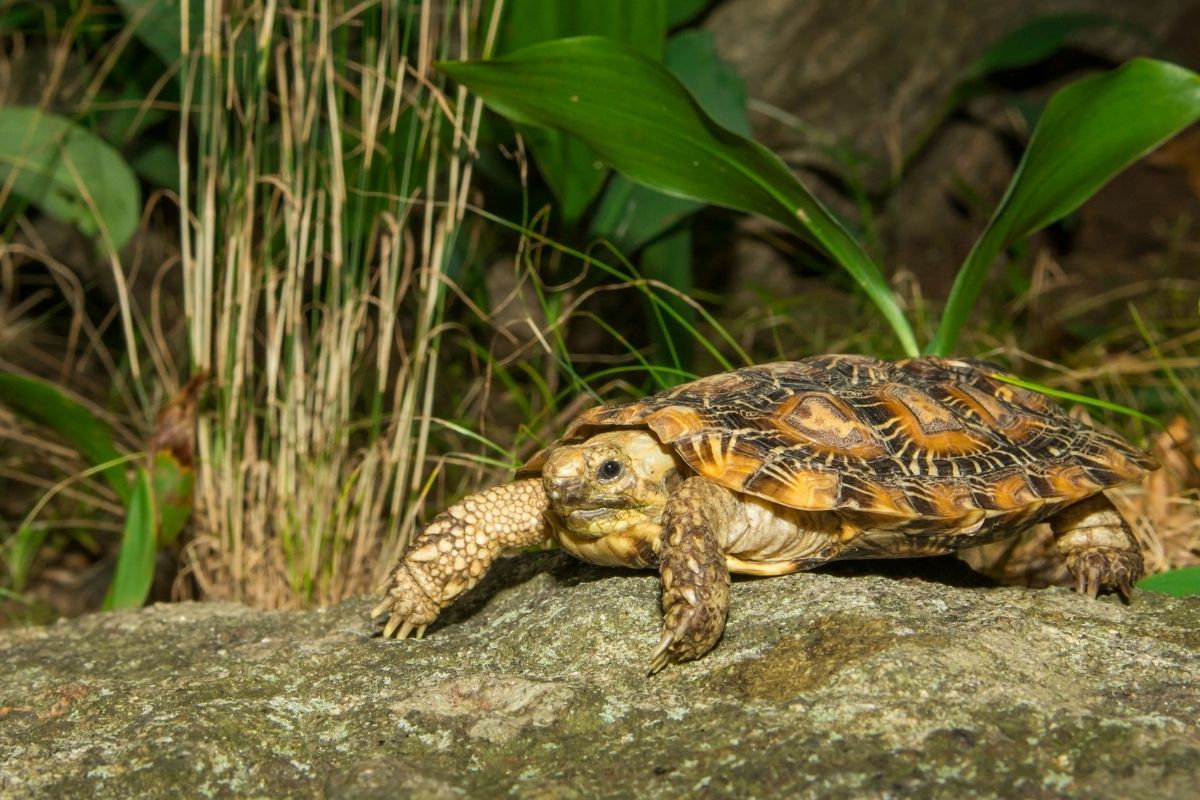
The Pancake Tortoise gets its name from its flat shell, as it stands out amongst all the domes of several other varieties of tortoise.
Though short, it should measure between six and seven inches and weigh little due to how flat the shell is.
This distinctive feature also makes it more agile as it is more lightweight than many varieties. Its tail only measures a single inch, too, and they require little space as only a four square feet enclosure is required.
Typically found in Southern Kenya and Tanzania, the Pancake tortoise adores the heat when it can be sampled in scrub forests and rocky hills.
In the wild, this breed can look after itself by being quick and flexible, but at home, it can be fun and gentle.
Make sure to look out for the Pancake tortoise when the temperature drops in winter and fall, when it is best kept indoors in an aquarium or terrarium.
Opt to place some rocks in the enclosure as a Pancake tortoise does enjoy climbing as that’s necessary for their natural habitat.
With that in mind, make sure that the enclosure has high walls so the tortoise cannot escape.
In terms of their living conditions, a basking area would be required with a UV light. The temperature only needs to be between 70 and 75°F with a humidity of around 60 to 70%.
Frequently Asked Questions
Why Do Mini Tortoises Make Such Great Pets?
Aside from remaining small and adorably cute, mini tortoises are also beneficial in a practical sense.
By remaining small, you can benefit from knowing that you can hold the tortoise the same way despite its advancing years.
A mini tortoise should be simple to handle and easy to hold with little risk of dropping it.
With the size of the tortoise being small, that means it only needs a small enclosure to fit in as it will not take up a huge amount of space.
This could make it the ideal pet to keep in a bedroom or studio apartment as opposed to a large dog.
The appetite of a small tortoise also makes it a good option as it will eat very little food. Tortoises fail to have huge appetites anyway, but you can benefit from looking after one that is even smaller.
Why Should I Consider Getting A Larger Tortoise?
There are certain drawbacks when you do opt to get a small tortoise that is worth considering.
One is simply that they are less safe for children, and the other pets that you may have as children can be so excited that they mishandle and hurt a small tortoise.
The tortoise may also be more at risk of being damaged due to a playful dog or cat, as their shells are less resilient compared to larger tortoises.
You may also find that you have more options with a larger tortoise as they can be less vulnerable to difficult weather conditions and the threat of predators.
With a smaller tortoise, you will be expected to keep it indoors, which can seem quite restricting.
There is also the matter of price, as mini tortoises, particularly Russian ones, can cost upwards of a hundred dollars. Then there are Egyptian tortoises which can cost upwards of a thousand dollars in some cases.
Finally, larger tortoises may simply be easier to find than mini ones. Mini tortoises are considered exotic pets, and finding one at your local pet store can prove quite difficult.
You may have to shop around and head to bigger pet stores or take your time to call up various ones to find one in stock.
Final Thoughts
Remember that rare tortoises, such as mini varieties, will require particular licenses and documentation, which typically come with additional fees.
They should be bought from licensed and trusted local breeders as this may be the only legal option for a tortoise that will stay mini forever.
Be careful, as you do not want to be serving jail time for wildlife trafficking.
Small tortoises can make great pets due to how long they can live and how little care they may require.
They do require some precise humidity levels and temperatures, yet once that is set up, they do not need much food. Size does matter with a tortoise, and a mini one can have several legal requirements.
Take care of the documentation, take care of the mini tortoise, and you can have a pet for quite some time.
